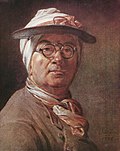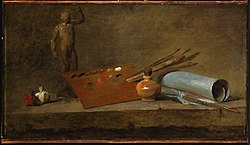File:Chardin, Jean-Baptiste Siméon, Attributes of the Painter, ca. 1725-27.jpg

Original file (2,000 × 1,162 pixels, file size: 329 KB, MIME type: image/jpeg)
Captions
Captions
Summary[edit]
| Jean-Baptiste-Siméon Chardin: Attributes of the Painter
|
||||||||||||||||||||||||||||
|---|---|---|---|---|---|---|---|---|---|---|---|---|---|---|---|---|---|---|---|---|---|---|---|---|---|---|---|---|
| Artist |
artist QS:P170,Q207447 |
|||||||||||||||||||||||||||
| Title |
English: Attributes of the Painter |
|||||||||||||||||||||||||||
| Object type |
painting object_type QS:P31,Q3305213 |
|||||||||||||||||||||||||||
| Description |
English: Catalogue Entry:
Chardin practiced an art form that, by tradition, was not of a high rank: in the academic hierarchy, still life was placed lower than history painting, portraiture, genre scenes, or even animal painting. Parisian by birth and at first apprenticed to history painters, Chardin found a vocation in the humble genre of still-life painting, although he also painted figural scenes of contemporary life, combining children or kitchen maids with still-life elements. As Chardin rose from shop-sign painter to member of the Royal Academy of Painting and Sculpture (where he was admitted to the ranks as a painter of still life in 1728), he gained the admiration of artists and collectors, and even the art critic Denis Diderot, who considered him a genius. These paintings, probably a pair of overdoors for a small study, testify to Chardin’s preternatural powers of observation and ability to render different substances in paint. They also are moral portraits of the owners of the tools, the artist and the architect. It has been noted that the dabs of paint on the palette are the colors used in the painting, as if the artist were providing a glimpse of his working practice. Attributes of the Painter includes a further wry, self-referential element in the small sculpture, which Jennifer Montagu has identified as a model by François Duquesnoy for the executioner holding up the head of John the Baptist in a sculpted tableau of the martyrdom of Chardin’s patron saint. Gallery Label: In the hierarchy established by the Royal Academy of Painting and Sculpture in ancien régime France, still-life painting ranked lower than history painting, portraiture, genre scenes, and even animal painting. Yet Chardin turned this apparent disadvantage into a strength, with collectors and critics delighting in the illusions of reality that he produced. His concern for creating a total visual experience through composition, spatial manipulation, color, and a loose painting technique led his contemporaries to observe that his still lifes—which, close up, read as a flurry of strokes—have a startling immediacy and naturalism. In Attributes of the Painter the artist’s palette shows the actual colors of pigments used in the painting, providing a record of the artist’s method of organizing his working tools. |
|||||||||||||||||||||||||||
| Date |
circa 1725 date QS:P571,+1725-00-00T00:00:00Z/9,P1480,Q5727902 -27 |
|||||||||||||||||||||||||||
| Medium |
oil on canvas medium QS:P186,Q296955;P186,Q12321255,P518,Q861259 |
|||||||||||||||||||||||||||
| Dimensions |
height: 50 cm (19.6 in); width: 86 cm (33.8 in) dimensions QS:P2048,50U174728 dimensions QS:P2049,86U174728 frame: height: 70.8 cm (27.8 in); width: 108.9 cm (42.8 in); depth: 6.2 cm (2.4 in) dimensions QS:P2048,70.8U174728 dimensions QS:P2049,108.9U174728 dimensions QS:P5524,6.2U174728 |
|||||||||||||||||||||||||||
| Collection |
institution QS:P195,Q2603905 |
|||||||||||||||||||||||||||
| Current location |
European Art |
|||||||||||||||||||||||||||
| Accession number |
y1935-4 |
|||||||||||||||||||||||||||
| Place of creation | France | |||||||||||||||||||||||||||
| Object history | ?Anonymous sale, Paris, May 15, 1879, lots 27-28; anonymous sale, Paris, April 19, 1880, lots 8-9; anonymous sale, Lair-Dubreuil, Paris, April 24, 1907, lots 13-14, to Flameng; François Flameng, Paris (1907–1919; sale, Galerie Georges Petit, Paris, May 26, 1919, lots 5-6); Jules Féral, Paris; Demotte, Paris and New York (in 1935; sold to Helen Clay Frick for Princeton University Art Museum). | |||||||||||||||||||||||||||
| Credit line | Gift of Helen Clay Frick | |||||||||||||||||||||||||||
| References |
|
|||||||||||||||||||||||||||
| Source/Photographer | Princeton University Art Museum | |||||||||||||||||||||||||||
| Permission (Reusing this file) |
|
|||||||||||||||||||||||||||
File history
Click on a date/time to view the file as it appeared at that time.
| Date/Time | Thumbnail | Dimensions | User | Comment | |
|---|---|---|---|---|---|
| current | 14:47, 12 January 2016 |  | 2,000 × 1,162 (329 KB) | Djkeddie (talk | contribs) | User created page with UploadWizard |
You cannot overwrite this file.
File usage on Commons
The following 3 pages use this file:
File usage on other wikis
The following other wikis use this file:
- Usage on fr.wikipedia.org
Metadata
This file contains additional information such as Exif metadata which may have been added by the digital camera, scanner, or software program used to create or digitize it. If the file has been modified from its original state, some details such as the timestamp may not fully reflect those of the original file. The timestamp is only as accurate as the clock in the camera, and it may be completely wrong.
| JPEG file comment | LEAD Technologies Inc. V1.01 |
|---|
Structured data
Items portrayed in this file
depicts
image/jpeg
550f25c29ca80f0b11677dc4f9df78fe6f4285b3
336,569 byte
1,162 pixel
2,000 pixel
- French paintings in the Princeton University Art Museum
- Still-life paintings in the Princeton University Art Museum
- Still life paintings by Jean Siméon Chardin
- 1720s oil on canvas paintings in the United States
- 1720s still-life paintings
- Overdoor paintings
- Paintings by Jean Siméon Chardin in the Princeton University Art Museum
- Galerie Georges Petit


